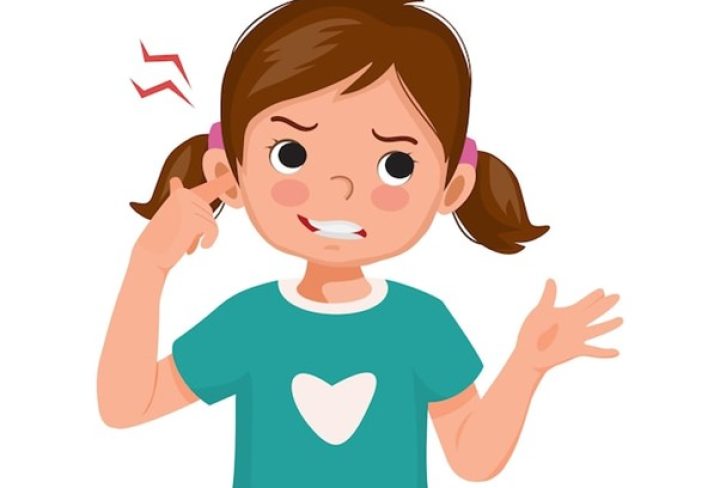Types of Ear Infections
1. Acute Otitis Media (AOM):
• Description: A bacterial or viral infection causing inflammation and fluid buildup in the middle ear.
• Common Age: Most common in children aged 6 months to 2 years.
2. Otitis Media with Effusion (OME):
• Description: Fluid remains in the middle ear without signs of infection. It often follows an episode of AOM.
• Common Age: Can occur at any age but is more frequent in younger children.
3. Chronic Otitis Media with Effusion (COME):
• Description: Persistent fluid in the middle ear without infection, lasting for three months or more.
• Common Age: Can affect children of all ages but more common in young children.
4. Otitis Externa (Swimmer’s Ear):
• Description: Infection of the outer ear canal, usually caused by bacteria or fungi.
• Common Age: Can occur at any age, often related to water exposure.
Symptoms and Signs
Acute Otitis Media (AOM):
• Ear Pain: Children may tug at or rub their ears.
• Fever: High temperature is common.
• Irritability: Increased fussiness or crying.
• Hearing Problems: Temporary hearing loss.
• Fluid Drainage: Yellow or white fluid may drain from the ear.
Otitis Media with Effusion (OME):
• Hearing Difficulty: Muffled or reduced hearing.
• Balance Issues: Mild balance problems.
• No Pain or Fever: Typically no pain or fever present.
Chronic Otitis Media with Effusion (COME):
• Persistent Hearing Loss: Continuous hearing difficulties.
• Speech Delays: Possible speech or language delays due to hearing loss.
Otitis Externa (Swimmer’s Ear):
• Ear Pain: Especially when the outer ear is touched.
• Itching: Itchiness in the ear canal.
• Redness and Swelling: Visible redness and swelling of the ear canal.
• Discharge: Watery or pus-like discharge.
Diagnosis
1. Physical Examination:
• Otoscope: A pediatrician uses an otoscope to look inside the ear for signs of infection, fluid, and inflammation.
2. Tympanometry:
• Test: Measures the movement of the eardrum to detect fluid in the middle ear.
3. Hearing Tests:
• Audiometry: Used to assess hearing loss, especially in cases of OME or COME.
4. Culture Tests:
• Ear Swab: In cases of otitis externa, a swab may be taken to identify the specific bacteria or fungi causing the infection.
Treatment
Acute Otitis Media (AOM):
• Pain Relief: Use acetaminophen or ibuprofen to relieve pain and fever.
• Antibiotics: Prescribed if the infection is bacterial. Follow the pediatrician’s instructions carefully.
• Observation: In some cases, the doctor may recommend waiting 48-72 hours to see if symptoms improve without antibiotics.
Otitis Media with Effusion (OME):
• Monitoring: Regular check-ups to monitor the fluid.
• Hearing Tests: Conducted if the fluid persists to assess hearing.
Chronic Otitis Media with Effusion (COME):
• Hearing Aids: May be recommended if there is significant hearing loss.
• Tympanostomy Tubes: Small tubes inserted into the eardrum to drain fluid and ventilate the middle ear.
Otitis Externa (Swimmer’s Ear):
• Ear Drops: Antibiotic or antifungal ear drops prescribed by the doctor.
• Pain Relief: Over-the-counter pain relievers.
• Keep Ear Dry: Avoid water exposure during treatment.
Prevention
1. Reduce Exposure to Infections:
• Hand Washing: Encourage frequent hand washing to reduce the spread of germs.
• Vaccinations: Ensure your child is up-to-date with vaccinations, including the flu vaccine and pneumococcal vaccine.
2. Breastfeeding:
• Duration: Breastfeed your baby for at least six months to boost their immune system.
3. Avoid Smoke Exposure:
• Smoke-Free Environment: Keep your child away from secondhand smoke, which can increase the risk of ear infections.
4. Proper Bottle Feeding:
• Position: Feed your baby in an upright position to prevent milk from entering the middle ear.
5. Limit Pacifier Use:
• Age: Reduce pacifier use after six months to lower the risk of ear infections.
6. Protect Ears from Water:
• Swimmer’s Ear Prevention: Use earplugs or a swim cap to keep ears dry while swimming. Dry ears thoroughly after exposure to water.
When to Seek Medical Help
Seek medical attention if your child:
• Persistent Symptoms: Shows symptoms of an ear infection that do not improve within 48-72 hours.
• High Fever: Has a fever above 102°F (39°C).
• Severe Pain: Experiences severe ear pain or discomfort.
• Hearing Loss: Exhibits signs of hearing loss or speech delays.
• Discharge: Has fluid, pus, or blood coming from the ear.
• Recurring Infections: Has frequent ear infections.
Conclusion
Understanding and managing ear infections in children is crucial for their health and well-being. By recognizing the symptoms, seeking timely diagnosis and treatment, and taking preventive measures, you can help ensure your child’s ear health. If you have any concerns or need further information, please do not hesitate to contact our hospital or visit our website.

